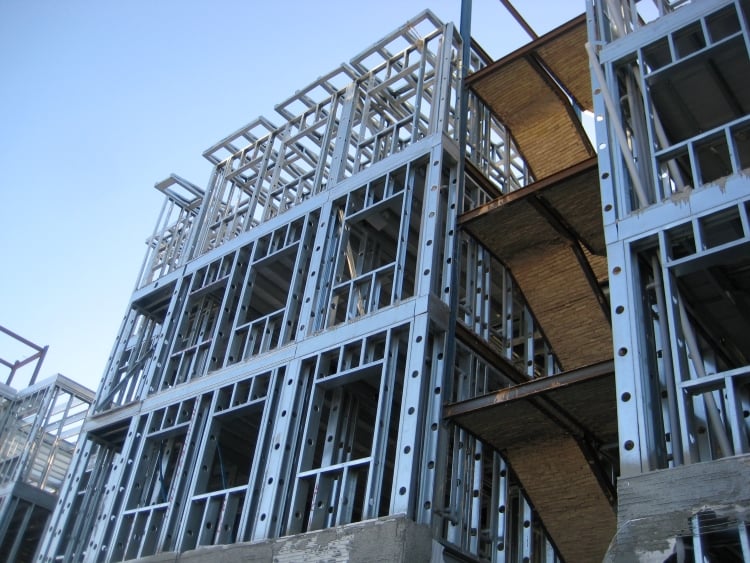In recent years, the construction industry has witnessed a shift in the housing market with the rise of Build-to-Rent (BTR) developments. These purpose-built residential properties, designed exclusively for rental purposes, have emerged as a significant force reshaping the approach to US residential construction.
We believe that the BTR trend is not just a passing fad but a lasting and transformative phenomenon that will continue to redefine the housing rental landscape. In this comprehensive article, we will delve into the enduring nature of the Build-to-Rent movement, explore its impact on the real estate industry, and analyze the key factors driving its sustained success, including the use of steel framing as a material.

Understanding the Build-to-Rent Model
Build-to-rent developments are significantly different from traditional residential properties in that they are purposefully designed, constructed, and managed for the sole purpose of renting out to tenants. These purpose-built communities prioritize the needs and preferences of renters, offering a range of amenities, services and flexible living arrangements. Unlike the traditional model of renting individual units within existing properties, BTR developments are designed as cohesive communities that foster a sense of belonging among residents.
The Resilience of Build-to-Rent
One of the defining characteristics of the Build-to-Rent trend is its resilience in the face of changing market dynamics. Unlike other real estate trends that may be susceptible to market fluctuations, BTR developments have demonstrated remarkable staying power. This enduring appeal can be attributed to several key factors.
Evolving Lifestyle Preferences
Shifts in lifestyle preferences and housing needs have contributed to the increasing demand for rental properties. Factors such as changing demographics, urbanization and a desire for flexibility have fueled the growth of the rental market in residential construction. BTR developments offer modern, well-designed living spaces that cater to these evolving lifestyle preferences, ensuring their relevance in the market.
Rental Housing Shortage
The persistent shortage of affordable and premium rental housing in many regions has further propelled the growth of BTR developments. As the supply-demand imbalance continues to widen, the need for purpose-built rental communities has become increasingly evident. These developments provide a solution by offering high-standard rental units that address the housing shortage and contribute to the overall residential housing market stability.
 |
 |
The Benefits of Build-to-Rent for Developers
Build-to-rent developments offer a multitude of advantages for developers, further bolstering their appeal and long-term viability.
Long-Term Stability
They provide a stable, long-term investment opportunity for developers and investors. The demand for rental properties is expected to remain robust, offering steady rental income and the potential for capital appreciation. This stability attracts institutional investors who view BTR developments as a reliable asset class within the real estate market.
Reduced Sales Risk
Build-to-rent developments don't have to rely on the uncertain sales market. The risk of selling individual units is eliminated as the developer becomes the landlord and assumes the responsibility of managing and leasing the units. This reduces the potential impact of market fluctuations and removes the need to wait for units to be sold before generating income.
Economies of Scale
Developments typically involve larger-scale projects, which can lead to economies of scale in terms of construction costs, financing, and property management. Developers can benefit from cost savings in the construction phase due to the bulk purchasing of materials and streamlined construction processes. Additionally, managing a larger number of units in a single development can be more efficient than dealing with multiple smaller projects.
Long-Term Asset Value
There is an opportunity for developers to build and hold long-term income-generating assets. The rental income generated by the development can increase the overall value of the property, making it an attractive investment option. Additionally, the potential for rental growth over time can enhance the asset's value, especially in high-demand rental markets.
Prefabricated Cold Formed Steel Building Components
To further enhance the efficiency, standard and sustainability of BTR developments, the integration of innovative construction methods has become crucial. One such method gaining prominence is the use of prefabricated cold formed steel building components. These advanced components are designed, manufactured, and assembled off-site and offer a range of benefits.
Speed and Efficiency
Prefabricated CFS building components significantly reduce construction timelines compared to traditional onsite methods. The simultaneous production of components with site preparation allows for streamlined construction, enabling developers to deliver rental units to the market more quickly and efficiently.
Enhanced Quality Control
The controlled factory environment in which prefabricated components are manufactured ensures consistent standards and precision. Utilizing advanced technology and automation minimizes human errors, resulting in superior construction standards and improved durability of Build-to-Rent developments.
Cost Savings and Sustainability
Although the upfront costs of prefabricated components may be marginally higher, they offer long-term cost savings. The accelerated construction process reduces on-site labor requirements, resulting in significant cost reductions that are associated with extended construction periods. Moreover, prefabrication minimizes material waste and supports sustainable construction practices.
Design Flexibility and Adaptability
Prefabricated components provide developers with design flexibility, allowing for customization and adaptation to meet specific project requirements. This adaptability ensures that BTR developments can cater to diverse tenant needs, optimize living spaces, and create unique architectural designs that align with market demands.
Integration of Technology
Prefabrication aligns well with the integration of advanced technologies such as Building Information Modeling (BIM) and Computer-Aided Design (CAD). These technologies enable seamless coordination, improve communication among stakeholders, and streamline the overall construction process.
Conclusion
As the demand for rental housing continues to grow, the enduring nature of the BTR trend becomes increasingly evident. By embracing the benefits of BTR developments and leveraging the advancements offered by companies like FRAMECAD, developers can create exceptional rental communities that meet the expectations of today's tenants. The future of the US rental housing market lies in the fusion of tenant-centric design, professional management, innovative construction methods and technological advancements. The Build-to-Rent movement, supported by the integration of prefabrication using steel framing, is poised to shape the rental housing landscape for years to come.
You may also be interested in reading Stronger and Straighter Steel Frame Homes and the Health Benefits of Steel Framed Homes and Steel Framing and Social Responsibility.
Discover more in our residential eBook.








